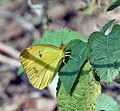Ixias marianne: Difference between revisions
No edit summary |
Nilupulcool (talk | contribs) No edit summary |
||
| Line 55: | Line 55: | ||
{{reflist}} |
{{reflist}} |
||
==External links== |
|||
*[http://www.wildreach.com/butterflies/Ixias_marianne.php Sri Lanka Wild Life Information Database] |
|||
==References== |
==References== |
||
Revision as of 14:08, 15 October 2010
| White Orange Tip | |
|---|---|

| |
| Female (Photo by Santosh Namby Chandran) | |
| Scientific classification | |
| Kingdom: | |
| Phylum: | |
| Class: | |
| Order: | |
| Family: | |
| Genus: | |
| Species: | I. marianne
|
| Binomial name | |
| Ixias marianne (Cramer, 1779)
| |


The White Orange Tip (Ixias marianne) is a small butterfly of the family Pieridae, (the Yellows and Whites) found in India and Sri Lanka.
Description
| Template:Wikify is deprecated. Please use a more specific cleanup template as listed in the documentation. |
Wet-season brood.

Male upperside is chalky-white with the apical half of fore and terminal margin of hind wing broadly black, the black on the latter broadest anteriorly. Fore wing: a broad rich orange patch obliquely across the black area extended to the upper apex of the cell, narrowed posteriorly and spread above the tornus into interspace 1 ; opposite the apex of the cell this orange patch is very broad and leaves only the apex of the wing and a comparatively narrow band along the termen and costa black ; base of the wing irrorated with black scales.
Underside : rich sulphur-yellow as in most of the forms of the genus, irrorated with fusco-ferruginous, short, transverse striations and minute dots. Fore wing : the orange patch of the upperside plainly seen by transparency on the disc ; a broadly triangular area below the cell white ; discocellular spot large and prominent, centred with white. Both fore and hind wings with the discal transverse series of reddish-brown spots, in other forms characteristic of the dry-season broods, present and more or less conspicuous, the spots always centred with white ; on the fore wing the patch above the tornus prominent and in some specimens very large. Antennae reddish brown, head and thorax anteriorly with reddish-brown hairs, thorax above with white hairs, abdomen black ; beneath : head, thorax and abdomen white.[1]

Female is similar with the upper fore wing having the orange patch on the black apical area narrower, posteriorly truncate, not extended below interspace 2 ; an outer transverse series of four black spots on the orange parch in interspaces 2 to 5. Underside as in the male , the markings slightly larger. Antennae, head, thorax and abdomen similar.
Dry-season brood. In both sexes this differs less from the wet-season form than it does in Ixias pyrene and Ixias verna. The characteristic dry-season markings on the underside are more pronounced, sometimes remarkably so.
Wing expanse of 54–56 mm.
Found from the NW Himalayas to Kumaon, Punjab, Bengal, central, western and southern India. Sri Lanka. �
Food plants
Gallery
-
Wet-season form in Hyderabad, India.
Notes
External links
References
- Evans, W.H. (1932) The Identification of Indian Butterflies. (2nd Ed), Bombay Natural History Society, Mumbai, India





